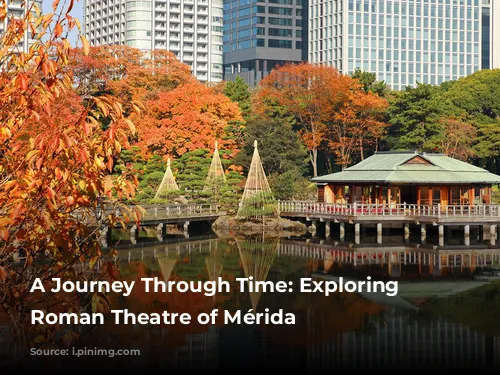Imagine stepping back in time to ancient Rome! The Theatre of Mérida, a breathtaking testament to Roman grandeur, transports us to an era of captivating performances and vibrant public life.
A Theatre Built on History
This magnificent theatre, erected during the reign of Emperor Augustus, stands as a symbol of the Roman colony of Emerita Augusta. Its construction, dating back to 16-15 BC, coincided with the city’s elevation to the provincial capital of Lusitania. The theatre’s strategic location on a hillside significantly reduced construction costs, with its foundation built partly into the natural slope. The remaining structure was skillfully crafted from concrete and adorned with elegant ashlar masonry.
Seating Arrangements and Social Hierarchy
While the Romans weren’t known for their love of theatre, a prestigious city like Emerita Augusta couldn’t afford to be without this vital venue. The theatre boasted an impressive capacity of around six thousand spectators, reflecting the city’s flourishing population. Seating arrangements were carefully designed to reflect Roman social hierarchy, with spectators distributed across three distinct sections: the summa cavea, media cavea, and ima cavea. These sections were separated by corridors and barriers, ensuring a structured and orderly experience. Accessing these tiers was easy, with convenient staircases radiating around the seating areas. Convenient walkways, known as vomitoria, allowed spectators to reach their seats smoothly.
The Theatre’s Evolution Through Time
The theatre’s past whispers through the ages, leaving behind traces of its transformation. The summa cavea, the top tier, was the only part that survived until the start of excavations in 1910. The vaults of its entrances had crumbled long ago, leaving only the seven pillars of the grandstand, inspiring the locals to christen these ruins as the “Siete Sillas” (Seven Chairs).
The ima cavea, reserved for the city’s elite, underwent a significant makeover during the reign of Emperor Trajan. A sacred space, surrounded by a marble railing, was erected at its heart, further elevating the experience for its distinguished occupants. Three wider and lower stands, located in front of the ima cavea, provided prime seating for judges and priests, who enjoyed the spectacle from movable chairs. These individuals accessed their seats through large side doors located at both ends of the stands. Above these doors, platforms for the sponsoring judges were strategically placed.
The Stage: A Window into Performance
The orchestra, the semicircular space that once housed the choir, boasts a marble floor, a testament to later renovations. Behind the orchestra, a wall adorned with circular and rectangular exedras served as the backdrop for the stage. The stage itself was originally a wooden platform, concealing the intricate machinery that powered the theatrical rigging system.
A wall, thirty feet high, known as the scaenae frons, enclosed the stage. This imposing structure featured two rows of columns, between which statues of deified emperors and underworld deities graced the space. The entire structure rested upon a podium, lavishly decorated with exquisite marble. Three openings within the scaenae frons served as entrances for the actors. The central one, the valva regia, was topped with a lintel that held the seated statue of Ceres, the goddess of agriculture, or perhaps Livia, the deified wife of Augustus. A wooden canopy, likely hung from the crown of the scaenae frons, enhanced the already excellent acoustics of the venue.
Beyond the Stage: A Sacred Space
Behind the imposing scaenae frons lay a spacious porticoed garden, surrounded by walls. These walls, punctuated by niches, were once decorated with statues of members of the Imperial family. At the heart of this portico, aligned with the valva regia and the sacred space within the ima cavea, lay the aula sacra. This small, sacred space housed an altar where the figure of the Divine Augustus was venerated, underscoring the connection between power and the theatre.
A Christian Legacy: The Theatre’s House-Basilica
At the western end of the Theatre’s portico lies the intriguing Theatre’s House-Basilica, a dwelling whose history is intertwined with the early days of Christianity. The dwelling’s entrance faces west, opening onto a road paved with flat slabs of diorite, a testament to its connection to the city’s infrastructure. The dwelling’s fauces (entrance hall) led to a series of rooms arranged around a porticoed courtyard, in whose center the remnants of a pond can still be seen.
Some rooms still preserve fragments of intricate mosaics, adorned with geometric and plant motifs. Beyond the courtyard lie the apsed rooms, encroaching upon areas that once formed part of the Theatre’s portico. These rooms were likely covered by barrel vaults, with semi-spherical caps adorning their apses. The remaining sections of the walls, plastered and painted, exhibit imitation inlaid marble on the plinths. The lower third of some figures, possibly servants, adorned in colored tunics and brocade fabric, remain in the apse area, hinting at a past of vibrant life.
While the floor of the apse area was likely adorned with marble, the rest of the room was embellished with a mosaic featuring a krater (a large mixing bowl) inscribed within a square.
This fascinating dwelling, known as the House-Basilica, offers a glimpse into the complex evolution of the theatre, its connections to Roman power, and its role in the spread of Christianity. Its remnants tell a story of the interwoven tapestry of history and culture.
